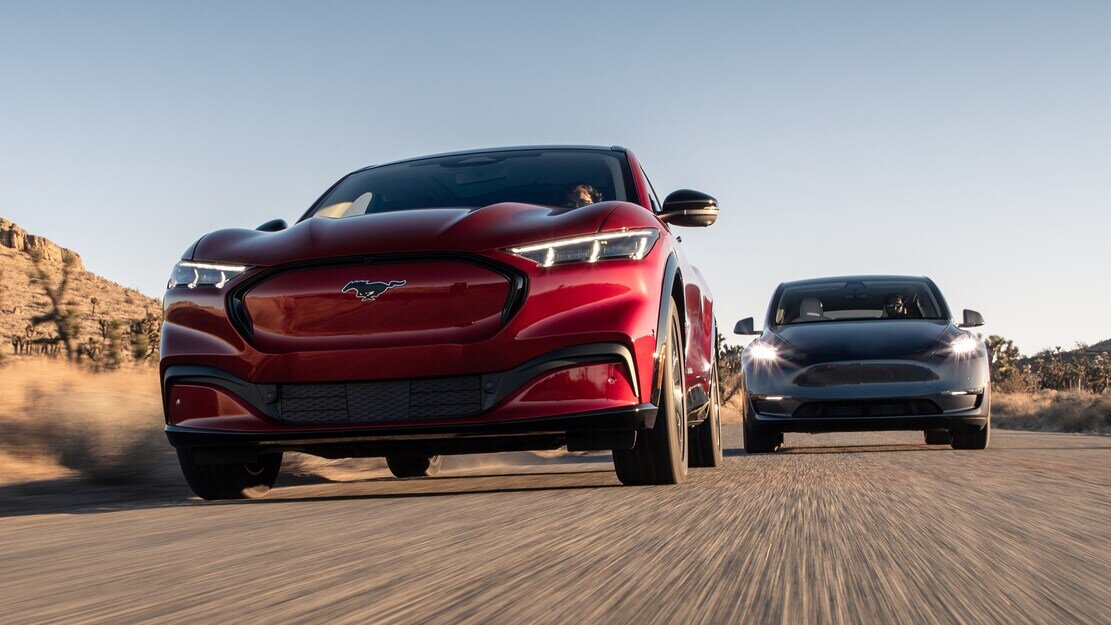2021 Ford Mustang Mach-E vs. Tesla Model Y: The Next Normal (MotorTrend)
Electric SUVs are proliferating apace, and which one rules the roost can change by the day.
Elon Musk's approach to running a company is anything but conventional, but whatever you might think of him or his strategies, there's little doubt of his indelible impact across multiple industries, including aerospace, personal technology, and, yes, automotive. His vision is a central reason Tesla has come to dominate today's EV market despite — or perhaps because of — its relative lack of history or legacy. Yet in just 18 years, the electric car manufacturer has gone from producing small-volume baubles like the original Roadster to pumping out hundreds of thousands of mainstream crossovers and sedans like the Model Y and Model 3. Of course, Tesla's vehicles are only part of the story. The history books are likely to give Musk and his firm just as much credit for sending nearly every other company scrambling to build proper EVs and for the hype created around Tesla and green vehicles.
And Tesla is certainly a large reason the Ford Mustang Mach-E exists. Originally conceived as a front-drive, Fusion-based electric crossover under former CEO Mark Fields, the Mach-E was reshaped when Fields' replacement, Jim Hackett, underscored its importance by telling executives the "heart of the company's on trial here." Jim Farley, who succeeded Hackett as CEO but was then Ford's president of global markets, steered the project in the direction of the Mustang brand, which clicked with designers and engineers. The vehicle adopted rear drive and targeted 300 miles of driving range, and although the final product isn't a carbon copy of Tesla's Model Y, you can tell which vehicle was in Ford's sights.
Our Model Y and Mach-E test vehicles are closely aligned in terms of performance, range, and size. Our Model Y Dual Motor Long Range is a 2020 model sourced from our friend Richard Hak at Precision One Design; its novel, disparate front and rear motors make 384 horsepower and 375 lb-ft of torque combined, and it is EPA-rated for 316 miles of range (that rises to 326 for 2021). Power is transmitted through a single gear ratio at each end, providing all-wheel drive. Its base price is just shy of $52,000, but with the $10,000 Full Self-Driving Capability option, paint, and interior options, the Tesla's final sticker rings in at $63,190.
The 2021 Mustang Mach-E 4x shares the same basic setup as the Tesla—front and rear electric motors, two single-speed automatics, and all-wheel drive. Powertrain output stands at 346 horsepower and 428 lb-ft, and the EPA states it can travel 270 miles on a single charge. This model starts at $55,800, with a few additional bits and pieces elevating our Mach-E to $56,450. Those interested in the Mach-E will be pleased to know it is still eligible for federal tax incentives; Tesla has cumulatively sold too many electric vehicles for its offerings to qualify under existing federal regulations (though legislation introduced in February could change that).
In the end, will the Blue Oval's electric SUV have the goods to take it to Tesla? Or is the Model Y still king of the heap? To find out, we gathered examples of each, drove them back to back, examined the charging experiences, and poked and prodded their interiors.
(photo credit: Brandon Lim - Motor Trend)




